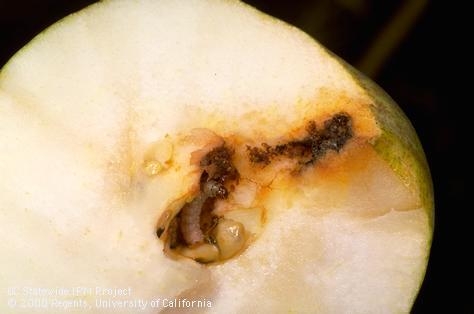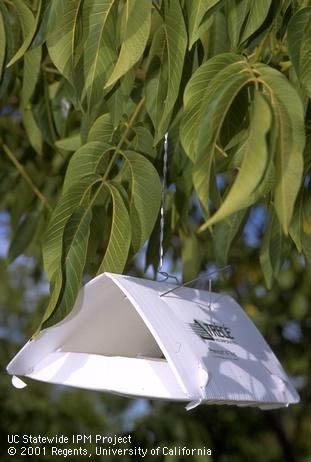[From March 2013 issue of the Retail Nursery and Garden Center IPM News.]
March is the time to start preparing to manage codling moth on apples and pears in backyard trees. Left unmanaged, the insect can be devastating to the crop.
Life Cycle. The immature stage of the codling moth is the infamous “worm” in the apple or pear (Figure 1). This pest spends the winter as a mature larva in a pupal case on trunks of trees or in debris around the home orchard. When spring temperatures rise in March, pupae mature and adult moths begin emerging in late March to April. Moths mate and lay eggs on leaves. Eggs hatch several weeks to a month later, and the larvae almost immediately bore into small fruit that has just begun to develop.
To control codling moth with insecticide sprays, you must apply the spray to target the larva just after it hatches and before it bores into fruit, where it will be protected. This requires very careful timing. Sprays applied well before larvae hatch or after larvae bore into fruit won't be effective.

Spray Timing by Monitoring Stings on Fruit. For those who don't want to use pheromone traps and calculate degree-days, sprays can be timed, although less accurately, by monitoring the first stings on fruit. Stings are the entry points of larvae and are marked by tiny mounds of reddish-brown frass (Figure 3). Start looking for them three to four weeks after bloom, and spray as soon as you see the first sting. 
Insecticides. Available effective spray products for codling moth include spinosad, carbaryl, and codling moth granulosis virus (Cyd-X). Cyd-X is the safest product for use around bees and other beneficial insects but isn't available in many stores. Spinosad is an organically acceptable product that is very safe for people, pets, and the environment, although it is more toxic to beneficials than Cyd-X. Spinosad can be made more effective by adding 1% horticultural oil to the spray mixture. After the first spray, two additional sprays at 10-day intervals should be applied. Carbaryl is also effective and doesn't need to be sprayed as often, but it is quite harmful to natural enemies and bees.
Nonchemical Control. For customers who don't want to use 
For more about pesticide sprays, degree-days, bagging, and other nonchemical methods, see Pest Notes: Codling Moth at http://www.ipm.ucdavis.edu/PMG/PESTNOTES/pn7412.html.
This article was originally published in the March 2013 issue of the Retail Nursery and Garden Center IPM News. See this and other articles at http://www.ipm.ucdavis.edu/RETAIL/retail-newsletter.html.